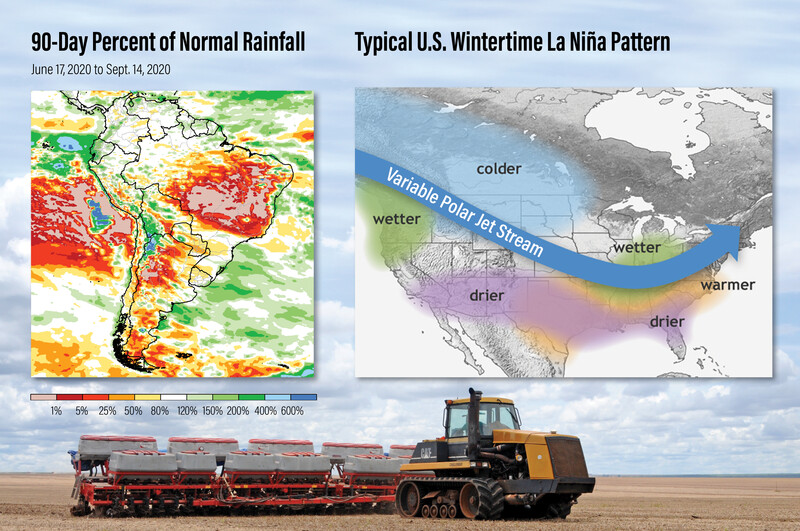
It might be harvest season in North America, but planting is just ramping up in the southern hemisphere.
“It has been dry there the last 90 days,” says Kirk Hinz, BAMwx meteorologist. “They’re absolutely going into planting with much less soil moisture than last year.”
What’s behind this dry weather pattern? La Niña. The event occurs when colder-than-normal ocean temperatures are in the equatorial central Pacific, which can inhibit rain-producing clouds forming in South America.
“We have seen a propensity for drier conditions in most of Brazil over the last four to five months — even drier than normal,” says Thomas Downes, Weather Bell Analytics meteorologist. “Northern Argentina has also been cold and dry over the last several months.”
The Major Impact On Row Crops
The South American corn crop will be more likely to be affected than soybeans if the La Niña pattern holds, adds Mark Brusberg, USDA meteorologist.
“In some of the past La Niña years, dryness hits sometime around December and January when the bulk of their corn is in reproduction,” Brusberg says. “Contrary to what a lot of people believe, we see the biggest impact being on the corn crop in Argentina, and potentially Brazil, rather than the soybean crop.”
In September, National Oceanic and Atmospheric Administration’s Climate Prediction Center reported a 75% chance La Niña will be in place from December through February 2021, which is right in the heart of the South American growing season.
“2017/18 is the closest in strength and intensity of a La Niña to what we’re experiencing right now,” Hinz says. “That was one of the most historic droughts in Argentina’s history or at least in 40 years.”
Not only was there dryness in Argentina, but the Brazilian rainy season started slow.
“That pushed corn planting back,” Brusberg says. “So, if the corn crop goes in a couple of weeks late, and if it dries out early, then they can have a poorer than expected corn crop.”
Regardless of the weather, South American farmers have ample monetary incentive to plant every acre of corn or soybeans they can in 2020.
“I have never seen the South American farmer so happy,” says Dan Basse, president of AgResource Company. “The price of soybeans in reals and the price of corn in reals are at levels higher than 2012 when we had beans at $16 to $18 and corn was over $7.”
October and November are big planting months for South American farmers.
“So, we really won’t have a good feel as to what the season looks like until probably November or maybe even December,” Downes adds.
In the U.S., La Niña often features drier and warmer-than-normal conditions in the Central Plains in the fall and in the Southeast over the winter. The Pacific Northwest is more likely to be wetter than normal in the late fall while being wet and colder in early winter.








 User Center
User Center My Training Class
My Training Class Feedback
Feedback












Comments
Something to say?
Log in or Sign up for free